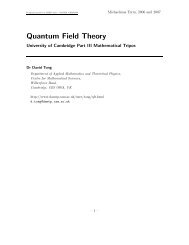CHAPTER 4. THERMODYNAMICS: THE FIRST LAW
CHAPTER 4. THERMODYNAMICS: THE FIRST LAW
CHAPTER 4. THERMODYNAMICS: THE FIRST LAW
You also want an ePaper? Increase the reach of your titles
YUMPU automatically turns print PDFs into web optimized ePapers that Google loves.
4-23<br />
Review Questions<br />
1. Define open, closed, and isolated thermodynamic systems.<br />
2. What is a state function? List some state functions. List some non-state functions.<br />
3. Define a reversible process.<br />
<strong>4.</strong> Calculate the work involved in each of the following:<br />
a).<br />
b).<br />
A balloon containing 1 mole of O at 298 K is suddenly ejected into outer space from the<br />
2<br />
space shuttle. (Neglect the elastic force of the balloon).<br />
A bubble in a bottle of champagne expands when the bottle is uncorked. Assume the<br />
bubble contains 0.3 mg of CO at 1.5 atm and 5 C, and that the outside pressure is 1 atm).<br />
2<br />
c). The expansion in part b is carried out reversibly.<br />
5. Draw a PV diagram for parts (b) and (c) of problem <strong>4.</strong><br />
6. A sufficient amount of heat is transferred to 25.0 g of carbon tetrachloride at its boiling<br />
temperature (76.1 C) to cause it to evaporate inside a container with a frictionless piston. The<br />
external pressure is 1 atm.<br />
a).<br />
b).<br />
c).<br />
d).<br />
Does all the heat get changed into internal energy?<br />
If your answer to (a) was no, explain where the rest goes.<br />
The heat of vaporization of CCl is 30.00 kJ/mol. Calculate the internal energy change for<br />
4<br />
this process. (Neglect the volume of the liquid).<br />
After the CCl has evaporated, the outside pressure is reduced to 0.5 atm while the<br />
4<br />
temperature is kept constant. Calculate the change in the internal energy and the change in<br />
enthalpy associated with the resulting expansion.<br />
7. Derive the relationship between C P and C V for an ideal gas.<br />
8. Estimate the high temperature value of C for water vapor.<br />
V<br />
9. How much heat must be transferred to 3 mole of Ar to raise its temperature from 25 C to 100 C<br />
(a) at constant volume, and (b) at constant pressure?<br />
10. The standard heat of combustion of 1-hexene is -4034 kJ/mol. Calculate its standard heat of<br />
formation.<br />
11. Give a physical explanation of why C P is larger than C V.

















